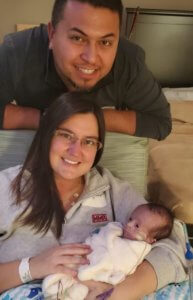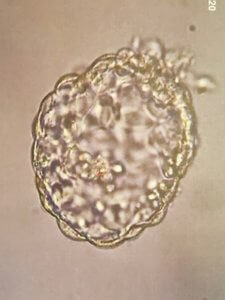New Orleans couple finds hope with PGT-M after heartbreaking loss of their son to a genetic disease

The year after Amanda and Gerald married in 2017, they decided it was time to add a baby to their family. They had spent their first year as a newly married couple traveling and exploring the world, but felt something was missing. They were ready to become parents and were so excited to begin this journey together.
To their surprise, pregnancy came easy for them and they rejoiced with their family and friends. They heard their baby’s first heartbeat, and it was music to their ears. But when they returned for a follow-up ultrasound, the room fell silent. “It was the most dreadful, stinging silence I have ever felt,” remembers Amanda. She and Gerald were devastated and she blamed her body for failing her. But through the tears and the whys, they decided to move on. Nothing was going to stand in their way.
What they didn’t realize at the time was how significant this next journey would affect their lives.
After 8 months of letting her body get back to normal post-miscarriage, Amanda and Gerald were excited and anxious to be pregnant once again. They prayed that the next few weeks would be uneventful and they could come out on the other side of the first trimester “danger zone” unscathed. To their relief, this pregnancy held on, and they celebrated the 12 week mark by announcing their soon-to-be baby to family and friends.
But at 21 weeks, Amanda woke to terrible pains in her back and pelvic area to the point that she could hardly stand. After a trip to the hospital it was determined her baby was fin, but that she was passing kidney stones. Before being released home, however, her doctors decided to do an ultrasound of the baby to make sure she wasn’t going into preterm labor. During the ultrasound, the tech asked if they wanted to know the gender, but Gerald and Amanda wanted to keep that a secret.
Once the tech was finished, the doctor came in and did a screening all over again, which they thought was odd. Then the doctor told them news that was heartbreaking: their sweet baby was showing signs of fluid on the brain as well as what appeared to be a hole in the heart. “In this moment, with the shock of the news and tears rolling down our cheeks, we decided we wanted to know what our little one was,” remembers Amanda. “We opened the envelope and the words “It’s a Boy” stared back at us. We were so excited and so overcome with joy that we were having a boy that for an instant all that mattered was us and our little boy.”
The kidney stones proved to be a blessing in disguise for Amanda and Gerald. Finding out about their baby’s problems early in pregnancy allowed them to see a high risk OB who monitored Amanda regularly. Knowing also allowed their doctors to determine what would need to be done the moment their son entered the world. But as her pregnancy progressed, ultrasounds revealed more problems with their son. It appeared that he also had a double bubble, or duodenal atresia, of his stomach and his intestines were not attached.
“He was going to need to be a fighter.”
While the doctors continued to tell Amanda and Gerald that all these things were fixable with surgery post-birth, they were heartbroken even more. Why was this happening to not only them but to their sweet, innocent boy? They went home that evening and decided to name him Roman. “We chose this name because it is a strong, warrior name and with everything going on he was going to need to be a fighter,” says Gerald.

At 30 weeks, Amanda’s water broke. As with the rest of her pregnancy, everything seemed to be on Roman’s time, and, ready or not, here he comes! She was admitted to the hospital and the doctors kept her monitored to see if she could hold out a bit longer. But a week later, Roman decided he was ready to meet his mom and dad. “Time seemed to stand still,” says Amanda. “He was absolutely amazing and our hearts exploded with love for our sweet , four-pound baby boy.”
Their neonatologist told Amanda and Gerald that Roman was very sick, and not only did he have fluid on his brain, a hole in his heart, a double bubble and his intestines were not connected, but he also had webbing in his throat, making it hard to intubate him, a cleft palate and a blocked aortic arch. Subsequent genetic testing revealed that Roman had Cri Du Chat Syndrome with a deletion of the 5th chromosome.
Roman had surgery to correct his stomach and intestinal issues, but he needed to wait until he was stronger to endure the surgeries required to fix his heart and the fluid on his brain. But at three weeks old, his army of specialists were at a crossroads. Roman’s heart was rapidly failing and he wouldn’t make it. A week later, Amanda and Gerald were given the option to bring their baby home on hospice care. “The moment we walked in the door of our house, our life was complete. Roman was so at peace in his home and just looked around in awe,” remembers Amanda. “We had the most amazing five days with Roman at home. He is forever and always our hero.”
Genetic testing can help couples with genetic diseases have healthy children
After life became more bearable, Amanda and Gerald did genetic testing on themselves which revealed that Amanda carried the chromosome abnormality. With a high chance of future babies having Cri du Chat Syndrome, their geneticist recommended they do IVF with preimplantation genetic testing for monogenetic disease, or PGT-M, to conceive. With a little bit of trepidation, they made an appointment with Dr. Neil Chappell at Fertility Answers.
PGT-M is used when patients know they have or carry a genetic disorder that can be passed down, such as the one Amanda carries. This technique can identify which embryos are affected by the disorder and which are unaffected. This testing is performed on embryos between the IVF steps of egg retrieval and embryo transfer. Amanda’s egg retrieval and subsequent fertilization yielded eight mature embryos which were biopsied to detect the Cri du Chat 5P- gene. Of these eight embryos tested, two did not carry the gene.

“Two genetically, beautiful embryos! It was a song to my ears,” says Amanda. “We had two beautiful babies waiting for us.” The couple quickly mapped out their transfer schedule with the Fertility Answers staff, started required medications, and a month later transferred one of those genetically perfect embryos. But as with all IVF cycles, this is the part where science can only go so far and we sit back and let Mother Nature take its course. After the dreaded two-week wait, Amanda’s pregnancy test was negative.
“We lost it, we were confused, we were angry, we were numb, we were BROKEN. All of the pain, all of the tests, all of the perfect timing, and we were let down.” Amanda and Gerald took some time off from treatment, but as they have done so many times before throughout their journey, they got back up and moved forward. Their second transfer of their last remaining good embryo proved to be the one and they are now anxiously and joyfully awaiting the arrival of their baby boy in December 2021.
“We are excited, we are scared, we have each other, the best team of doctors, the best family, the best friends, and the best gift of all, which is hope,” says Amanda. “And now we have dreams of a little piece of heaven waiting for us in a few months.”


